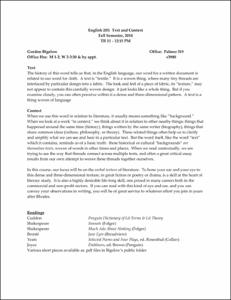Please use this identifier to cite or link to this item:
http://hdl.handle.net/10267/24340| Title: | ENGL 285, Text and Context, Fall 2014 |
| Authors: | Bigelow, Gordon |
| Keywords: | English, Department of;Syllabus;Curriculum;2014 Fall;Student research |
| Issue Date: | 27-Aug-2014 |
| Publisher: | Memphis, Tenn. : Rhodes College |
| Series/Report no.: | Syllabi CRN 15278; |
| Abstract: | Text The history of this word tells us that, in the English language, our word for a written document is related to our word for cloth. A text is “textile.” It is a woven thing, where many tiny threads are interlaced by particular design into a fabric. The look and feel of a piece of fabric, its “texture,” may not appear to contain this carefully woven design: it just looks like a whole thing. But if you examine closely, you can often perceive within it a dense and three-dimensional pattern. A text is a thing woven of language Context When we use this word in relation to literature, it usually means something like “background.” When we look at a work “in context,” we think about it in relation to other nearby things: things that happened around the same time (history), things written by the same writer (biography), things that share common ideas (culture, philosophy, or theory). These related things often help us to clarify and amplify what we can see and hear in a particular text. But the word itself, like the word “text” which it contains, reminds us of a basic truth: these historical or cultural “backgrounds” are themselves texts, woven of words in other times and places. When we read contextually, we are trying to see the way that threads connect across multiple texts, and often a great critical essay results from our own attempt to weave these threads together ourselves. In this course, our focus will be on the verbal texture of literature. To hone your ear and your eye to this dense and three-dimensional texture, in great fiction or poetry or drama, is a skill at the heart of literary study. It is also a highly desirable life-long skill, one prized in many careers both in the commercial and non-profit sectors. If you can read with this kind of eye and ear, and you can convey your observations in writing, you will be of great service to whatever effort you join in years after Rhodes. |
| Description: | This syllabus was submitted to the Office of Academic by the course instructor. Uploaded by Lorie Yearwood. |
| URI: | http://hdl.handle.net/10267/24340 |
| Appears in Collections: | Course Syllabi |
Files in This Item:
| File | Description | Size | Format | |
|---|---|---|---|---|
| 2014_FALL_ENGL_285_01_15278.pdf | 369.5 kB | Adobe PDF |  View/Open |
Items in DSpace are protected by copyright, with all rights reserved, unless otherwise indicated.